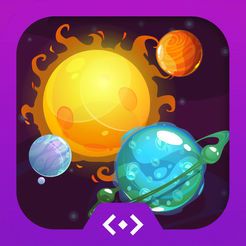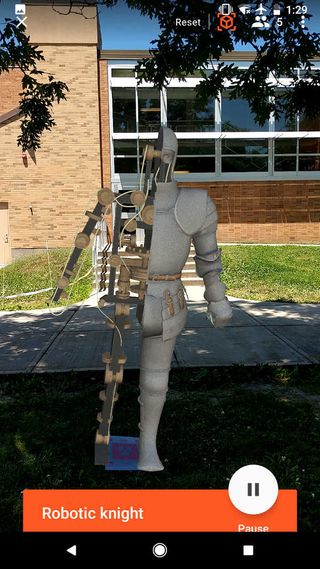There are times in a school year when we are able to try things out with students with less risk (meaning failure is ok). For me, one of those times is often found at the end of the school year and final exams are finished for the content goals and objectives are complete, it’s at these times I like to try out something new.
Recently, I asked my students to bring whatever devices they had access to from their homes to school if their parents would allow it. Being 7th graders I wasn’t too sure how many of the students would be allowed but nearly 70% came back to school with the devices. So we set out to employ BYOD (bring your own devices) with augmented reality.
I started by asking the students to download several apps including Merge Cubes’ Galactic Explorer and Google Expeditions. I realized employing students own devices in an activity of this nature would bring to the surface very quickly any problems one might have with multiple (different) types of devices and operating systems. My student phones ranged from iPhone 5, 6, 6s, 7, 8 and 10 to HTC, Samsung, Pixels etc… Admittedly there was a lot of troubleshooting going on in my classroom during this augmented reality and virtual reality experience. I found that with my own Pixel to lead with Google Expeditions I needed to go into airplane mode so that my students with various devices could join. I also realized a key problem: that several students did not have an updated AR Kit (iOS) for AR Core (Android) which would allow them to really engage In the augmented reality experiences being offered.
NOTE: Having class-set of common devices (like an iPad cart) can allow you to quickly troubleshoot and set up for more successful engagement.
Merge Cube’s Galactic Explorer

Galactic Explorer by Merge VR allows students to very quickly experience augmented reality in very impressive ways. This is a target based form of augmented reality meaning the Merge Cube needs to be in the sight of the phone’s camera in order to initiate the augmented reality experience. Galactic Explorer is an experience that shows students the solar system. Students can rotate the cubes and rotate their phones to see different celestial bodies from different perspectives and view an information pop-up about the planet they were viewing. I recorded a little bit of the experience my classroom and when I re-watched it I was excited to hear my students say “Oh, wow!” as they saw the different celestial bodies pop-out of the Merge Cube for the very first time. All I could think about was how cool it would be to have student created oral reports in a science class based on the solar system since students in Merge Cube are also able to record their experience so they could have a video of themselves talking about a planet while they hold it in their hand.

Google Expeditions

Google Expeditions has traditionally been a virtual reality platform that allows teachers to lead students on 360-experiences with content from all over the world. Most recently Google has released an update with Expedition’s that allows for augmented reality views of new content. In this AR experience, teachers can use targets around their classroom to lead students in the exploration of 3D, computer-generated models. All while leveraging one of the most powerful aspects of Google Expeditions… the shared experience. A whole class can have a conversation about what they’re all seeing together.

In my most recent use of Google Expeditions AR experiences, I brought my students outside and connected all of our devices together through a wireless router.* Outside, my students examined Leonardo da Vinci’s machines. I was struck by how the context of our learning really contributed to what they were seeing, meaning that my students were able to see natural resources everywhere trees, dirt, sand, grass, etc… and then look at da Vinci’s three-dimensional computer-generated models that were created Buy DaVinci using this very same natural resources. What struck me is that students were given an in-the-moment experience that was related to their immediate surroundings and allowed for them to retain a sense of mindfulness and awareness of the environment in which the great Renaissance Inventor, Leonardo da Vinci, was able to invent over 500 years ago.
Helping students to understand the power of technology, that many have access to, is a step towards preparing students for their future. While not every student has access yet, we can be assured that costs will come down and power will go up… see Moore’s Law. I believe an ancillary, teachable moment, in classroom experience I have described here, is perseverance… Yes, it needs to be taught. Yes it’s ok if students see us fail and troubleshoot. They need to know adults do have to figure stuff out and sometimes we are not as put together as we may appear.
*NOTE: I’m using a wireless router to connect to devices not through the internet but through a Wi-Fi connection. We often use the word Wi-Fi as a synonym for internet when actually Wi-Fi is a communication tool similar to Bluetooth that allows devices to communicate with each other. So using an old router and a phone charger with a brick I’m able to have our Devices connected by Wi-Fi.
cross posted at micahshippee.com
Micah Shippee, PhD is an out-of-the-box-doer, a social studies teacher, and a technology trainer. He works to bridge the gap between research and practice in the educational sector. Micah explores ways to improve motivation in the classroom and seeks to leverage emergent technology to achieve educational goals. As an innovative "ideas" person, Micah likes to think, and act, outside the box. Micah is motivated and energetic, taking a creative approach towards achieving goals. As an Educational Consultant, and Keynote Speaker, he focuses on the adoption of emergent technology through the development of an innovative learning culture. Micah believe that innovativeness is the pedagogy of the future.
